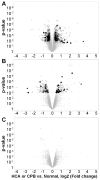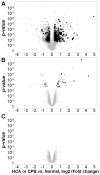Hawley H. Seiler Resident Award. Transcriptional profile of brain injury in hypothermic circulatory arrest and cardiopulmonary bypass
- PMID: 20494057
- PMCID: PMC3031914
- DOI: 10.1016/j.athoracsur.2010.02.051
Hawley H. Seiler Resident Award. Transcriptional profile of brain injury in hypothermic circulatory arrest and cardiopulmonary bypass
Abstract
Background: Little is known about the molecular mechanisms of neurologic complications after hypothermic circulatory arrest (HCA) with cardiopulmonary bypass (CPB). Canine genome sequencing allows profiling of genomic changes after HCA and CPB alone. We hypothesize that gene regulation will increase with increased severity of injury.
Methods: Dogs underwent 2-hour HCA at 18 degrees C (n = 10), 1-hour HCA (n = 8), or 2-hour CPB at 32 degrees C alone (n = 8). In each group, half were sacrificed at 8 hours and half at 24 hours after treatment. After neurologic scoring, brains were harvested for genomic analysis. Hippocampal RNA isolates were analyzed using canine oligonucleotide expression arrays containing 42,028 probes.
Results: Consistent with prior work, dogs that underwent 2-hour HCA experienced severe neurologic injury. One hour of HCA caused intermediate clinical damage. Cardiopulmonary bypass alone yielded normal clinical scores. Cardiopulmonary bypass, 1-hour HCA, and 2-hour HCA groups historically demonstrated increasing degrees of histopathologic damage (previously published). Exploratory analysis revealed differences in significantly regulated genes (false discovery rate < 10%, absolute fold change > or = 1.2), with increases in differential gene expression with injury severity. At 8 hours and 24 hours after insult, 2-hour HCA dogs had 502 and 1,057 genes regulated, respectively; 1-hour HCA dogs had 179 and 56 genes regulated; and CPB alone dogs had 5 and 0 genes regulated.
Conclusions: Our genomic profile of canine brains after HCA and CPB revealed 1-hour and 2-hour HCA induced markedly increased gene regulation, in contrast to the minimal effect of CPB alone. This adds to the body of neurologic literature supporting the safety of CPB alone and the minimal effect of CPB on a normal brain, while illuminating genomic results of both.
2010 The Society of Thoracic Surgeons. Published by Elsevier Inc. All rights reserved.
Figures





Similar articles
-
Serum levels of neuron-specific ubiquitin carboxyl-terminal esterase-L1 predict brain injury in a canine model of hypothermic circulatory arrest.J Thorac Cardiovasc Surg. 2011 Oct;142(4):902-910.e1. doi: 10.1016/j.jtcvs.2011.06.027. J Thorac Cardiovasc Surg. 2011. PMID: 21924148 Free PMC article.
-
Inflammatory profile in a canine model of hypothermic circulatory arrest.J Surg Res. 2021 Aug;264:260-273. doi: 10.1016/j.jss.2021.02.014. Epub 2021 Apr 8. J Surg Res. 2021. PMID: 33839341 Free PMC article.
-
Immediate-early gene expression in ovine brain after cardiopulmonary bypass and hypothermic circulatory arrest.Anesthesiology. 1996 Dec;85(6):1439-46. doi: 10.1097/00000542-199612000-00026. Anesthesiology. 1996. PMID: 8968192
-
Hypothermia, circulatory arrest, and the pediatric brain.J Cardiothorac Vasc Anesth. 1996 Jan;10(1):66-74. doi: 10.1016/s1053-0770(96)80180-7. J Cardiothorac Vasc Anesth. 1996. PMID: 8634389 Review.
-
Anesthetic Management for Proximal Aortic Repair.Semin Cardiothorac Vasc Anesth. 2025 Mar;29(1):8-36. doi: 10.1177/10892532251318061. Epub 2025 Feb 1. Semin Cardiothorac Vasc Anesth. 2025. PMID: 39891577 Free PMC article. Review.
Cited by
-
Nanotechnology Approaches to Targeting Inflammation and Excitotoxicity in a Canine Model of Hypothermic Circulatory Arrest-Induced Brain Injury.Ann Thorac Surg. 2016 Sep;102(3):743-750. doi: 10.1016/j.athoracsur.2016.02.077. Epub 2016 May 4. Ann Thorac Surg. 2016. PMID: 27154161 Free PMC article.
-
MicroRNA-194-5p Levels Decrease during Deep Hypothermic Circulatory Arrest.Sci Rep. 2018 Sep 19;8(1):14044. doi: 10.1038/s41598-018-32426-x. Sci Rep. 2018. PMID: 30232383 Free PMC article. Clinical Trial.
-
Serum levels of neuron-specific ubiquitin carboxyl-terminal esterase-L1 predict brain injury in a canine model of hypothermic circulatory arrest.J Thorac Cardiovasc Surg. 2011 Oct;142(4):902-910.e1. doi: 10.1016/j.jtcvs.2011.06.027. J Thorac Cardiovasc Surg. 2011. PMID: 21924148 Free PMC article.
-
Congenital cardiac anomalies and white matter injury.Trends Neurosci. 2015 Jun;38(6):353-63. doi: 10.1016/j.tins.2015.04.001. Epub 2015 May 1. Trends Neurosci. 2015. PMID: 25939892 Free PMC article. Review.
-
Inflammatory profile in a canine model of hypothermic circulatory arrest.J Surg Res. 2021 Aug;264:260-273. doi: 10.1016/j.jss.2021.02.014. Epub 2021 Apr 8. J Surg Res. 2021. PMID: 33839341 Free PMC article.
References
-
- STS. Society of Thoracic Surgeons National Database Executive Summary. 2009. [Accessed Sept 29, 2009]. Available at: http://www.sts.org/documents/pdf/ndb/2ndHarvestExecutiveSummary_2009.pdf.
-
- Redmond JM, Greene PS, Goldsborough MA, et al. Neurologic injury in cardiac surgical patients with a history of stroke. Ann Thorac Surg. 1996;61:42–7. - PubMed
-
- Roach GW, Kanchuger M, Mangano CM, et al. Adverse cerebral outcomes after coronary bypass surgery. Multi-center Study of Perioperative Ischemia Research Group and the Ischemia Research and Education Foundation Investigators. N Engl J Med. 1996;335:1857–63. - PubMed
-
- Newman MF, Kirchner JL, Phillips-Bute B, et al. Longitudinal assessment of neurocognitive function after coronaryartery bypass surgery. N Engl J Med. 2001;344:395–402. - PubMed
-
- Hogue CW, Jr, Palin CA, Arrowsmith JE. Cardiopulmonary bypass management and neurologic outcomes: an evidence-based appraisal of current practices. Anesth Analg. 2006;103:21–37. - PubMed
Publication types
MeSH terms
Grants and funding
LinkOut - more resources
Full Text Sources
Medical

